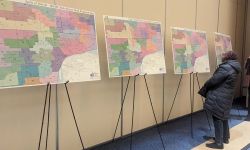What legal battle over racial makeup of Detroit districts means for Michigan

- Trial continues in federal redistricting case
- Three-judge panel considering whether Detroit-area political districts were drawn with race in mind, deprive Black voters of electing preferred candidates
- Commission maintains the maps meet legal requirements
KALAMAZOO — Did Michigan’s independent redistricting commission successfully unravel political gerrymanders in Detroit, “play dice” with Black voters by splitting their numbers across multiple districts or something in between?
A federal three-judge panel in Kalamazoo is prepared to decide, weighing the first major legal challenge to Michigan’s new system of drawing legislative districts.
At issue: In trying to make state maps less partisan, did commissioners go too far in lowering the percentage of Detroit-area districts, thus making it harder for people of color to elect candidates of their choosing.
Related:
- Former Michigan redistricting chair: process 'became all about race'
- Do Michigan’s political maps dilute power of Black voters? Trial will decide
- Michigan lawmakers consider end to ‘prison gerrymandering'
Deciding the case are three federal judges appointed by former Republican President George W. Bush: Raymond Kethledge, Paul Maloney and Janet Neff. They heard testimony this week from expert witnesses, former Detroit lawmakers and commissioners who helped draw the maps.
Attorneys for a group of Detroit-area voters contend that state legislative districts adopted in late 2021 and used for the first time in 2022 elections violated the federal Voting Rights Act and the 14th Amendment’s Equal Protection Clause by drawing majority-Black voters into districts with majority-white voters in Oakland and Macomb counties.
The commission maintains that mapmakers were doing what was necessary to comply with constitutional requirements and make fairer political maps — although some commissioners have aired differing views in court on whether their strategy worked.
Testimony resumes Monday. Here’s what you need to know about the trial so far:
What’s at stake
The case hinges on the commission’s strategy to split the city of Detroit into several long, skinny political districts that cross Wayne County’s border at Eight Mile Road and extend well into neighboring Oakland and Macomb counties.
The lawsuit contends commissioners violated the 14th Amendment by using race as the predominant factor when drawing Detroit-area political districts, and that they ran afoul of the Voting Rights Act by lowering the Black voting-age population in several districts to the extent that Black-preferred candidates won’t get elected.
Katherine McKnight, an attorney for the redistricting commission, testified that commission members did their best and extended Detroit-based districts into the suburbs because the commission couldn’t meet its legal requirements otherwise.
“It turns out redistricting is difficult no matter who does it,” she said.
Nine districts are being challenged: House Districts 1, 7, 10, 12 and 14 and Senate Districts 1, 3, 6 and 8. Judges are now also considering whether another four districts, House Districts 8 and 11 and Senate Districts 10 and 11, violated the 14th Amendment.
Sean Trende, a senior elections analyst for political website RealClearPolitics, analyzed the maps’ 2022 primary results. In court testimony, he zeroed in on the 8th Senate District, where the 2022 primary election pitted incumbent Sens. Mallory McMorrow, D-Royal Oak, and Marshall Bullock, D-Detroit, against each other.
In that district, where 40 percent of the voting age population is Black, Trende’s analysis of census and voting data estimated that likely Black primary voters favored Bullock 80-20 percent and likely white voters preferred McMorrow 96-4 percent.
McMorrow ultimately won the race by double digit margins.
“This looks like something out of Alabama in the 1960s,” Trende told the court.
Before last year’s elections, there were 15 Black lawmakers in the state House and five in the state Senate.
After the 2022 election that used the new maps, those numbers fell to 14 in the House and three in the Senate.
Ultimately, though, that may not be a determining factor to judges, who only must rule on whether the districts comply with the letter of the law — not whether they led to the election of enough minority candidates.
Packed or cracked?
The maps, which last 10 years, are by and large more competitive than their predecessors, and were a factor in Democrats winning a full legislative majority in the House and Senate for the first time in decades.
Commissioner Anthony Eid, one of the panel’s five politically independent members, told the court Friday that part of the group’s goal was to make the maps more fair — which in Michigan’s case meant splitting Detroit and other cities into a greater number of political districts.
“There was a general understanding of what we needed to do,” Eid said, noting that in order to reverse past gerrymandering, more Democratic districts needed to be created.
Michigan’s legislative districts were notoriously gerrymandered before voters created the independent commission through a 2018 constitutional amendment.
For decades, the districts were drawn every 10 years by the party in power in Lansing. The lines skewed Republican, allowing them to keep control of the Legislature for years even though their candidates sometimes received fewer overall votes in state elections than Democrats.
Historically, mapmakers in Michigan have achieved Voting Rights Act compliance by creating districts made up of 50 percent or more Black voters.
Doing so increased the likelihood that a minority candidate would be elected — but in some cases, experts have argued the “packing” strategy results in districts with so many people of color that it dilutes their voting power.
When the citizens commission began work on the maps, it faced a few challenges: Districts are drawn based on population, and Detroit’s population declined 10.5 percent from 2010 to 2020.
The commission operated under the theory that Black-preferred candidates could still be elected by “unpacking” districts — reducing minority representation to less than 50 percent while still making them a significant voting bloc.
The thinking is that previous elections showed significant crossover between Black and white voters in metro Detroit.
That decision was unpopular among many current and former Detroit lawmakers and other advocates, who have argued that the new maps make it harder for Black candidates to succeed.
'All about race'
The commission is spending millions to defend the current maps, but some commissioners, including former chair Rebecca Szetela, told the court that Detroit’s political district maps could have been better.
In hindsight, she said, the commission relied too heavily on advice from its lawyers and from experts hired to navigate compliance with the 1965 federal Voting Rights Act, which outlawed discriminatory voting practices, including legislative districts that limit the power of Black voters.
Testifying Wednesday, Szetela claimed the redistricting process "became all about race" due to the expert recommendations provided and ultimately resulted in commissioners aiming for specific percentages of Black voters in metro Detroit districts out of fear that majority-Black districts would violate the Voting Rights Act.
“I think the plan should be revised, and I think it can be revised,” Szetela said.
What comes next
The trial will resume Monday as the court hears from the commission’s hired experts and other witnesses.
After that, the three-judge panel will make a determination on whether the commission will have to change the maps to comply with federal law. If so, it’s possible other districts could be impacted in the process.
It’s unlikely the commission would have to redraw the entire state, said Michael Li, senior counsel for the Brennan Center for Justice’s Democracy Program.
Commissioners would “have a chance to figure out how they think they can solve the problem with guidance from the court,” he said, adding, “it's not a binary where it's all or nothing.”
But if the maps are revisited, constitutional requirements for public input and renewed line drawing would add a complicating factor to 2024 state House primaries.
See what new members are saying about why they donated to Bridge Michigan:
- “In order for this information to be accurate and unbiased it must be underwritten by its readers, not by special interests.” - Larry S.
- “Not many other media sources report on the topics Bridge does.” - Susan B.
- “Your journalism is outstanding and rare these days.” - Mark S.
If you want to ensure the future of nonpartisan, nonprofit Michigan journalism, please become a member today. You, too, will be asked why you donated and maybe we'll feature your quote next time!




